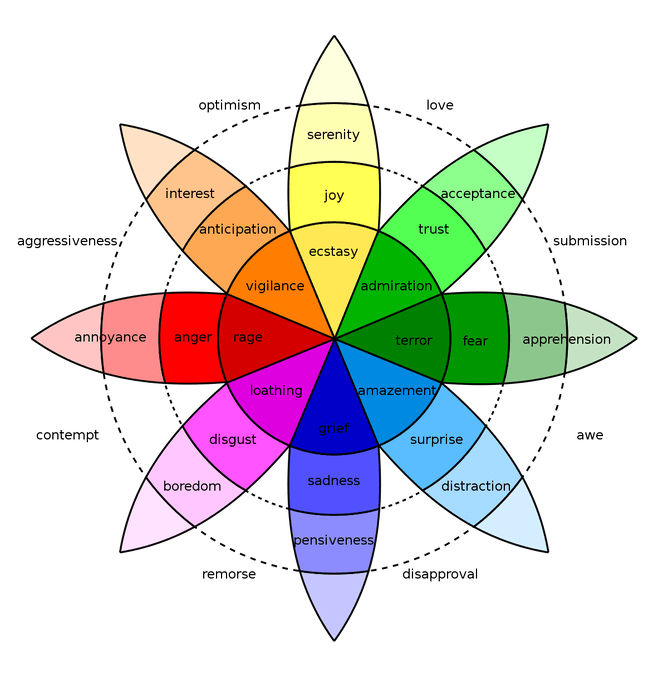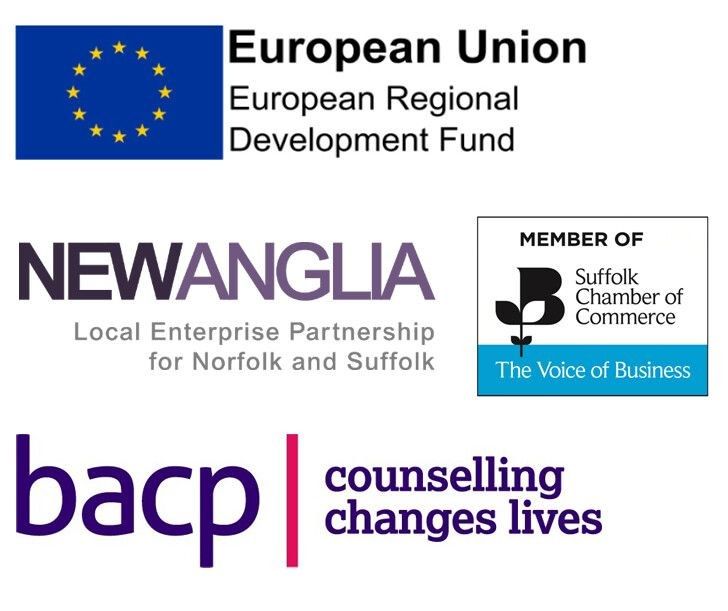Understanding one’s own emotions whilst being able to express and communicate them effectively can lead to healthier mental well-being and aid mental health recovery.
This blog will be looking at how to improve one’s emotional intelligence through the identification of unfamiliar emotions and how to manage them.
Identifying Emotions
Unfamiliar emotions can feel intimidating, this section gives insight on how to identify and reclaim one’s feelings as a first step to understanding them.
The emotions wheel or ‘Plutchick Wheel’ was created by Robert Plutchick in 2001 and is used to increase emotional literacy, meaning one can learn to broaden their understanding of emotional difference and description. To understand the range of emotions that can be felt and the differences between them means that one can identify their own emotions in a more coherent way.
Starting from the core of the wheel and working outwards, one can identify and accurately describe the emotion they are feeling, which is the first step to understanding why that emotion is being felt and how it can be dealt with.
Expressing Emotions
This next section describes how to utilise emotions more effectively through a traffic light system and mindful action matching. One can learn to live more authentically when genuine emotions are embraced and acted upon accordingly.
Although at first it may appear infantile, traffic lights can be effective in helping adolescents and adults effectively translate their feeling into a more manageable form and communicate this to the outside world.
Having a small traffic light picture in a bag or pocket means one can quickly take it out to assess their feelings; Green meaning ‘content, happy, positive’, amber meaning ‘unsure, on edge, concerned’ and red meaning ‘agitated, upset, angry, unwell’. The traffic lights can act as a sliding scale to monitor one’s emotional state when in public or used as a form of communication with friends, family or carers.
Examples include:
You are out shopping, you can feel your heart start to race as the aisle gets busy, you take out your traffic lights and quickly identify that you have moved from green to amber. You decide to go to the self check out so that you don't have to speak to strangers. You start making plans on how to move from amber to green once you leave the shop.
You are alone in your bedroom after having an argument with your parents and you feel your emotions are in the red zone of the traffic lights. After self soothing for a while (listening to music, talking to friends online, having a long shower) you feel like you have moved to the green traffic light. You can now go downstairs and tell your parents that you feel a lot better and try to resolve the argument in a calmer way.
Also note that the traffic light system can be completely unique to each person who uses it, it may be helpful to write a list of emotions that appropriately fit each colour. After using the emotions wheel and the traffic light system, one can learn to express their emotions appropriately through the pursuit of activities that are appropriate to the emotion experienced. Matching emotions mindfully to actions can help with the maintenance and regulation of mental well-being and is the best way to be kind to ones self.
Examples include:
- Dealing with anger appropriately by swapping a frustrating piece of homework for a calmer activity (such as self care) until the anger has passed.
- If you are feeling overwhelmed or anxious, buy your groceries online and have them delivered instead of going into a busy shop and risk having a panic attack.
- Take part in a creative hobby instead of impulsively spending money when feeling intense emotions such as excitement, hyperactivity or emptiness.
Dealing with difficult emotions
This section looks at the ways in which one can learn to understand and deal with negative
emotions such as anger, depression, fear etc. These can be very distressing emotions to experience
and many people often don't know how to handle them appropriately.
Everyone experiences negative emotions, they are a permanent part of life. Having intense negative emotions such as anger can be frightening, but it is important to remember that emotions are not dangerous and they will eventually pass. No feeling lasts forever.
If someone experiences negative emotions, it does not define them as a good or bad person, even if they feel negative emotions towards another. It is completely normal to feel hate, irritation, resent etc. towards another person as long as this is dealt with in a healthy way.
Being kind to one’s self and allowing negative emotions to be expressed when needed facilitates healthy psychological growth and prevents the build-up and overflow of suppressed emotional
overwhelm.
It can feel empowering to experience negative emotions in a regulated and healthy way. Learning to channel negative emotions into constructive expression can help to process uncomfortable thoughts and feelings into something more bearable e.g. Feelings of sadness expressed through art creation can turn into feelings of achievement, satisfaction and pride.
Replacing unhealthy or destructive coping mechanisms with safer, more productive activities can feel therapeutic and aid mental health recovery whilst maintaining the same desired effect of emotional expression.
Examples of healthier emotional channelling include:
- Art creation (sculpting, painting, drawing)
- Dance (this can be controlled, disciplined choreographed dance or just violent thrashing to loud music)
- Music (listening, singing, composing, playing an instrument)
- Safe destruction (ripping an old t-shirt, violently scribbling, ripping paper/old magazines,
- Smashing (ice on the ground, breaking large twigs)
- Writing (fiction, a biography, thoughts and feelings, random words, blogging)
- Physical exercise (running, leaning a new sport, yoga)
- Buy a plant and tend to it every time you feel upset
Distraction can include channelling, but this can feel too difficult when overwhelmed. If this is the case, less strenuous activities can help pass the time until the uncomfortable emotions eventually subside. Engaging in activities that require less concentration but still steer the focus away from feelings of overwhelm can help tremendously.
Examples include:
- Breathing in for 7 seconds and then breathing out for 11
- Counting objects (e.g. the number of chair legs in the room)
- Talking to a friend or family member
- Watching TV
- Going out for a walk
- Playing video games
- Taking a nap
- Take a shower or bath and play your favourite music
- Spend time with a pet
- Reading
- Having a hot drink and a snack
- Online window shopping
- Doing a puzzle or brain teaser
Written By: Holly Hawken
Teenage Mental Health Disclaimer:
We at Teenage Mental Health recommend anybody suffering with Mental Ill health speaks with their GP our local NHS services for advice and guidance in the first instance in all cases.
Our Blogs, information and advice are written and reviewed by experienced and highly qualified professionals working for Teenage Mental Health. Any information or advice shared via our blogs and social media however is not a substitute for first contacting medical professionals with your local GP.
All Teenage Mental Health Blogs, Social Media containing advice and information on social issues are privately funded by the company only and are not sponsored by external parties.

